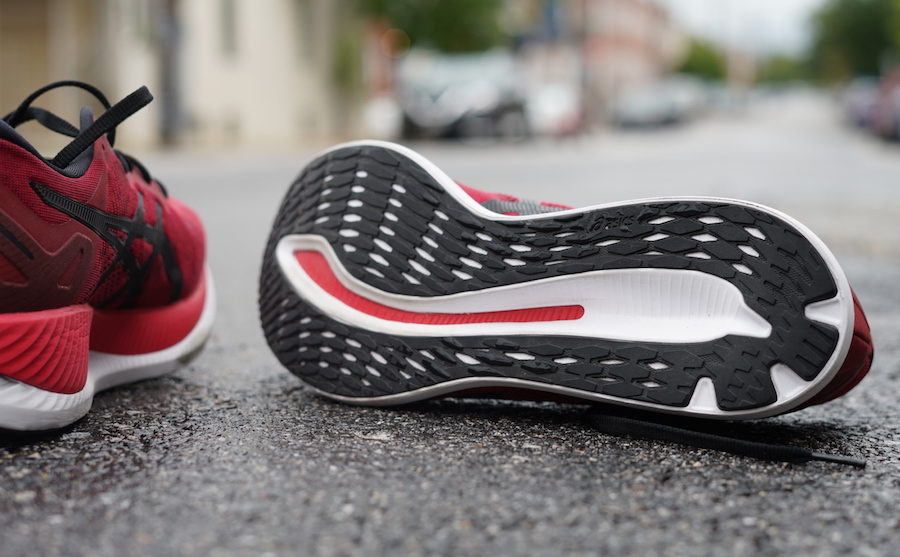
My record with ASICS has been kind of hit or miss.
While I will always have a soft spot for my first pair of real running shoes, I feel like ASICS hasn’t changed much in the last decade-plus since I that day I laced up my first pair. To be honest, I’ve been waiting for one of the largest running shoe companies on the globe to embrace change and innovation.
I am happy to report they are trying.
First, there was the Metaride, which was a miss for me. As such, I wasn’t exactly expecting much out of the similarly inspired Glideride. I am happy I went into this review with an open mind, cause I enjoyed running in Glideride.

Let’s start with the “multi-directional engineered mesh upper.” ASICS has a good track record with uppers and the Glideride doesn’t disappoint. Like the rest of the shoe, it’s made for comfort. It securely holds the foot over the rather large midsole.
The Glideride sports the most padded tongue and heel collar that I have tested this year, which bucks the trend of paper-thin minimalism. Also, if you like a very structured heel counter, the Glideride won’t disappoint. There isn’t anything about the upper you would not expect from ASICS.
Next, the midsole. This is where this shoe gets weird–in a good way. Like the first time you heard of goat cheese and were weirded out, but then realized it was legit good. The stack is high. It starts at 30 mm in the heel and drops to 25 mm in the forefoot. Honestly, the drop in this shoe is irrelevant. The midsole is a rocker and the toe spring is severe. This shoe rolls through the stride. Bonus: as a 5’11” dude, I loved standing over 6′ tall in these shoes.
The midsole is built like a sandwich. Top layer of Flytefoam (soft bread), an EVA plate Guidesole and tiny bit of GEL (lettuce and condiments), and the firmer layer of Flytefoam (tofu or meat). Can you tell I’m writing this review at lunchtime? Anyhow, all the parts work together and are noticeable in the final combination.
The top layer of Flytefoam is densely plush and does a wonderful job of giving a soft feel with a little springiness. The Guidesole adds stability and some pop of the toe. ASICS will tell you that the GEL is there to dampen the shock, but I think they just kept it in to protect their patent. Or they’re just all about living that GEL life. Finally, the firm layer of Flytefoam on the bottom sets the foundation for the entire platform and keeps the shoe from feeling overly mushy. All these parts create a unique ride and cushioning experience. I dig it.
Despite the trainer weighing 11.3 oz./322 grams, it doesn’t feel that heavy on the foot. The weight is distributed evenly throughout, unlike lighter trainers such as the Nike Zoomfly 3. Even after long mileage, the weight of the Glideride didn’t bother me.
Good news the designers through in lots of rubber on the outsole, this shoe can handle lots of mileage and dole out traction on the fly.
Shop ASICS Glideride

I ran 36 miles in the Glideride in a 3-day span. With cushioned shoes like this stacking up the mileage I start to feel stress in my hips and glutes. It would be easy to just get comfy in the Glideride and enjoy the cushioned miles, but I recommend mixing in some firmer trainers to avoid injury and muscle fatigue.
Shop ASICS Glideride

I had very low expectations for the Glideride going in. I honestly thought it was going to be the budget Metaride. It isn’t.
The Glideride shares characteristics with the Metaride, but is its own animal. This shoe isn’t meant to be fast, or compete with the Vaporfly. It is really good at what it is designed for–easy efficient, cushioned miles.
The 20-mile run I did in the Glideride did not have pace goals. I found my legs feeling fresh enough that I negative split the last 7 miles of the run. I wasn’t blazing, but it was a great feeling to be able to pick it up after 13 miles of easy running.
The Glideride will retail for $150, which is a pretty good value for this trainer. This shoe is a contender for easy mileage trainer of the year. Comparable shoes: Nike Zoomfly 3, Hoka Bondi, and the Nike Vomero 14.
Shop ASICS GliderideHave something to say? Leave a Comment
I know it’s relative–especially for those who review many shoes even more expensive–but it’s still hard for me to accept that $150 is a good value for any running shoe. I think the shoe companies and the running-journalism industry have succeeded in normalizing the high cost of running shoes. So many new types of midsole technology each year, but none designed to last for more miles.
We don’t disagree with you. Beer and shoes have gotten outrageous over the last few years. I would say $150 is a “comparatively” fair price for a shoe these days, but in terms of true value, everything should come down to that Brooks range.
Oh~ Thomas.
I need a chicken sandwich, too.
I’m 100+ miles in on these shoes and I just don’t like them. They are so “heavy handed” in their assertiveness towards changing my stride mechanics that any run beyond mid distance my joints feel the push & pull between my natural mechanics and this shoe. If I ran in only this shoe, I’m sure I’d be beaten into submission, but I have different shoes for different contexts.
To add, to get the aggressive rocker mechanic the forefoot is much too stiff and the outsole compound, while durable, is incredible slippery in wet/damp conditions. Coming into fall running, that poses a problem with a shoe that I just want to quickly get my miles on so that I can retire it and move on.